New York City Carriage Horse Facts by
Kim Sanford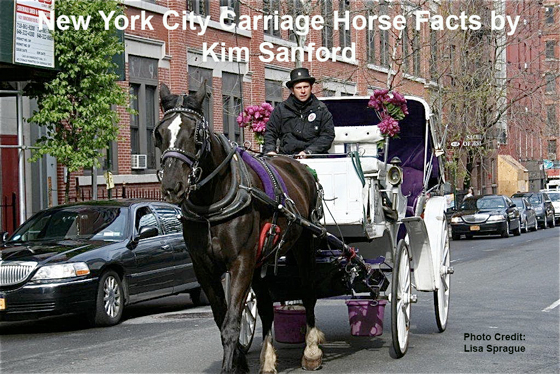
There is a battle being fought in New York City and it has been going on for at least twenty years. It has reached a wider audience because the mayor made a campaign promise to abolish horse-drawn carriages from the city as one of the first things he would do if elected. He won the election and the fight has escalated. I had the opportunity to go to the city last month to see for myself, to see if the charges were true. I wanted to share what I saw and it is not what the mayor and the animal rights groups want us to believe.
The use of electric cars has been proposed to replace the horses/carriages for tourists to ride in to view Central Park. These cars are not wanted by Park and Rec or the D.O.T. The weight of the car itself is a major concern…these cars weigh about seven thousand pounds, which is more than a ¾ ton pickup. Advocates for the blind are against using the cars because they are too quiet for the blind individuals to hear approaching vehicles which makes them inherently dangerous…horses on the other hand can be easily heard by the pedestrians. Their inaudibility and weight make electric cars a hazard for use in the park regardless whether a person is blind or sighted.
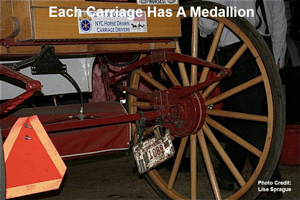 There is a set of checks and balances put in place to monitor the welfare/usage of every horse. Every time a horse departs the stable his driver will punch a ticket before they leave and when they return at the end of the shift. This ticket has a number that corresponds to the one branded on the hoof of the horse…this number also is on the horse’s harness tag attached to bridle. Each carriage has a medallion (license plate) displayed on the undercarriage. This system makes it easy to keep track of how long the horse worked and IF any injury occurred while he was out on the streets.
There is a set of checks and balances put in place to monitor the welfare/usage of every horse. Every time a horse departs the stable his driver will punch a ticket before they leave and when they return at the end of the shift. This ticket has a number that corresponds to the one branded on the hoof of the horse…this number also is on the horse’s harness tag attached to bridle. Each carriage has a medallion (license plate) displayed on the undercarriage. This system makes it easy to keep track of how long the horse worked and IF any injury occurred while he was out on the streets.
While we are speaking of accountability…these people (carriage drivers) are held to what has been referred to as a “utopian standard”, where nothing negative ever happens unlike ANY other industry. C’mon horse people, we need to speak up…anyone who is or has been around horses and who claims to be knowledgeable about them should realize that Murphy's Law applies tenfold when dealing with horses. We could literally put them in bubble wrap, which by the way would not make them happy, and they still would manage to do something to them self because of something...you get my drift right? This business is heavily regulated and the drivers will also police themselves. If someone is not doing the right thing by their horse there is always another driver who is going to hold him/her accountable. Inhumane treatment will never be tolerated. What I saw was a brotherhood/sisterhood of drivers looking out for the horses and each other...they are willing to step up and help each other at any time.
Not surprisingly most horses are purchased from Amish families in Lancaster Co., Pennsylvania. Most of the New York City carriage horses are generally what the Amish consider family horses…those that have been handled by the wives and children on a daily basis. Many have worked in the fields and/or been used for the day-to-day errands about the neighborhoods. The “flashier” Sunday go-to-meeting horses are generally not considered suitable because they tend to be “hotter” and more reactionary than the family horses. A very important part of New York City carriage horse training is learning to walk and stand quietly. They are rarely asked for a trot at speed, a jog is the fastest gait allowed. Concussion and stress to the legs and feet is minimal so because of this so they stay sound.
Draft horses and draft crosses abound but Standardbreds and Morgans are well represented. A long well established working relationship is not uncommon between the owners and the sellers. Often the same Amish families will sell horses to the carriage owners/drivers time and again. It is also not uncommon for the horses purchased to spend their “vacation” time on the farms of the families they were bought from. Consistency important in a horse’s life and this practice tends to keep them healthy and content. Incidentally the carriage horses are rested longer/more often than the mandated five weeks.
Blue Star Equiculture (B.S.E.) is where the majority of the horses go to retire if they do not retire at an owner’s personal farm. Horses from B.S.E. are then able to be retired for their lifetime or if suitable, they are adopted by private individuals. Those adopting a former New York City carriage horse from Blue Star are required to have references as well as a contract. These adoptable animals are sought after BECAUSE their life in the city has contributed to their value as reliable, unflappable, and safe partners. They are not in danger of entering the slaughter pipeline because of this. They have VALUE and a job that translates into safety. Retirement age will depend on the individual horse …some horses work well into their late teens oreven early twenties and thrive at it while others may retire earlier for many reasons. Of course there will be the occasional horse that gets fed up (sour) in some cases and it will act out. Does it mean it was abused to make him that way? The answer to that is absolutely not. The truth of the matter is that some horses just get tired of doing a certain task/job and that happens in every discipline. In those rare cases the horse is phased out of the business and is rehabbed into a new life or retired outright.
The horses are hitched to the carriages at the stables and are then driven to the plaza. The drivers are mandated to “take the most direct route” to the staging area in the park and then back to the barns. We saw several on their way to the park in the morning as we were walking to the stables. I closely watched as they jogged or walked by us, all were alert and eager to be heading out. The quality of their gaits was easily evaluated by watching them go by and by listening. Not one of them showed any sign of discomfort…the footfalls echoed off the buildings in an even cadence.
An interesting fact shared by one of the drivers which made it obvious that the quote, “safety issues” for the horses Mayer de Blasio has said is the reason he is pursuing the ban, is a fallacy is that the city provides dedicated lanes to other entities for example, bicyclists. But it has never offered a dedicated lane to the carriage industry. So, if keeping the horses safe was truly a concern, then why have the horses not been given that lane to help ensure they get where they need to go, park to barn, “safely”? That of course begs the question…what about New York City drivers? Do they not have a responsibility to be aware of the horses and drive accordingly?
Again, as I was watching things on the plaza I have to say that horses are not the problem; though the traffic circling the plaza could certainly be (impatient drivers blowing horns, making quick decisions, speed). Both horses and drivers handled it all by skillfully maneuvering from the exit of the park across this traffic to the staging area.
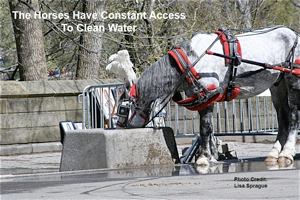 There is a water trough for the horses at the beginning of the Central Park loop as well as at the end. They are constantly filled automatically throughout the day during all four seasons. This gives the horses a chance to drink often and I saw this throughout the day. Drivers allowed the horse to stop to drink each time they passed the trough. Whether the horse drank or not was completely up to him during each pass.
There is a water trough for the horses at the beginning of the Central Park loop as well as at the end. They are constantly filled automatically throughout the day during all four seasons. This gives the horses a chance to drink often and I saw this throughout the day. Drivers allowed the horse to stop to drink each time they passed the trough. Whether the horse drank or not was completely up to him during each pass.
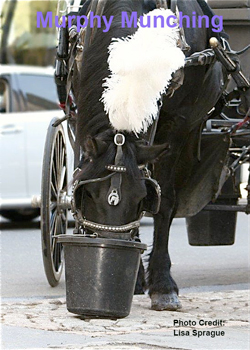
A bucket of feed is hung on every carriage when it leaves the stables and the horses are offered feed periodically; it is monitored by the drivers so they will not eat too much at one time…this could cause a case of colic that could be fatal. Every horse I saw who was offered the feed did not dive ravenously into the bucket nor did they care much when it was taken away. This tells me that they are getting plenty of food throughout the day since generally horses are food driven and if they feel a lack they will be more insistent and/or eager for that bucket of feed. These horses definitely wanted their food but were not worried when it was removed because they knew it would be back in a reasonable amount of time.
At the end of the day we went back to the stables at 618 W52nd St. The barns are staffed 24/7…with three stable hands on duty each shift. The stables are in what appeared to be a freshly painted brick building and they were incredibly clean. The first floor is where the carriages are stored and where the horses are hitched. It is clean, from top to bottom. We climbed a ramp to the stable area on the second floor. It is lined with thick rubber mats and the traction is excellent. A rope is attached to the wall as a handrail to help the humans up the ramps, the horses manage it just fine. Once we got to the second floor I was struck by how light and airy it is. Again, it was not what I was led to believe from the negative reports/comments of people who had no knowledge of what they were talking about.
During the tour I saw virtually no cobwebs and very little dust, all of which are fire hazards in a barn. If you maintain horses you know how difficult that is to achieve. The aisles were clear of any obstacles and debris; there were fans strategically placed throughout the structure to circulate and remove stale air. There was also an air vent system that funneled clean air into all the stalls via holes cut into it. This ran the length of the stall areas and was positioned so that air did not blow directly into the stall creating a draft that could chill the horses. All windows were open…in stalls and at ends of the aisles…creating sufficient air flow.
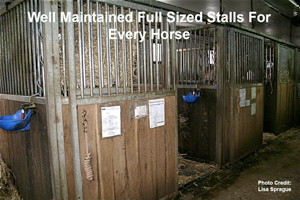 Each stall had automatic water bowls that the horse could activate by pushing a paddle for water. They were bedded with thick straw and all of them had mangers stuffed full of good quality grass hay. The walls went up about four feet or so and then there were bars that allow the horses to see each other so their social needs were being met. There were horses in some of the stalls and even a few lying down. It has been said that the horses stand in manure and cannot lie down. Well, I am here to tell you that the barn was immaculate; it had a pleasant smell of horses and fresh manure, no odor of ammonia and no smell of liniments.
Each stall had automatic water bowls that the horse could activate by pushing a paddle for water. They were bedded with thick straw and all of them had mangers stuffed full of good quality grass hay. The walls went up about four feet or so and then there were bars that allow the horses to see each other so their social needs were being met. There were horses in some of the stalls and even a few lying down. It has been said that the horses stand in manure and cannot lie down. Well, I am here to tell you that the barn was immaculate; it had a pleasant smell of horses and fresh manure, no odor of ammonia and no smell of liniments.
Each horse’s medical history was posted on their stall which means they can easily checked by ANYONE at ANY TIME. They receive regular veterinary and farrier care…every visit is recorded.
Feed is customized to account for the type of horse (mostly draft and draft crosses), for the time of year and taking into consideration the metabolism of each type of horse, light breeds as well as the heavier breeds. Feed is high in fat content, and beet pulp is also utilized to take in the roughage needs of the horses…this in addition to the free choice hay back at the barn.
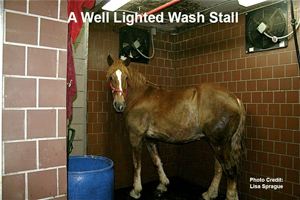 The well-lighted wash stall was equipped with hot and cold water so the horses can be bathed no matter what the temperature outside.
The well-lighted wash stall was equipped with hot and cold water so the horses can be bathed no matter what the temperature outside.
These are just a few of the things I saw that solidified my stance on the carriage horse controversy…they should be allowed to stay in the city. By all means if a horse were being abused I say go after the abuser with “guns blazing” but to attack an entire industry with what amounts to lies is contemptible. This is not abuse, it is horses and people earning a living in a city where they have been since it became a city…they have adapted to the conditions within their industry admirably. They are heavily regulated, they are transparent, they are (and should be) here to stay. Keep the faith.


